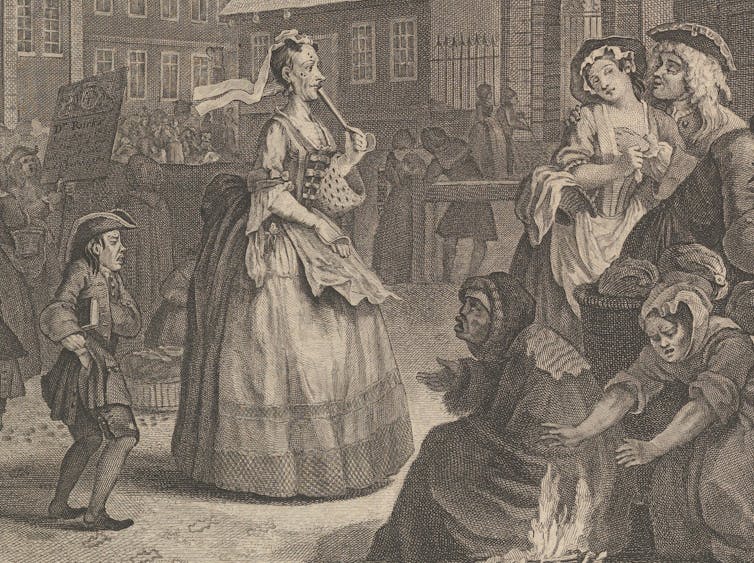Taxing bachelors and proposing marriage lotteries – how superpowers addressed declining birthrates in the past
- Written by Amy Froide, Professor of History, University of Maryland, Baltimore County
There’s growing awareness – and concern – about declining birthrates[1] in the U.S. and other countries around the world.
Falling birth rates are usually seen as a sign of societal decline, a nation’s diminishing power, and the eclipse of marriage and family values. Rarely are they put into any kind of historical context. But birthrates are cyclical and have gone up and down throughout history[2].
While some people might assume that the decision to have a child is a personal or private one, individuals and couples also respond to external forces. Economic, social and cultural factors heavily influence birth rates. As a historian[3] who has researched the uptick of single people[4] in the 17th and 18th centuries, I’m familiar with how governments and societies have traditionally responded to low marriage and birthrates with various persuasion techniques.
In the 1690s, England and France entered into a 120-year period of continuous hot and cold warfare[5]. The two nations were also superpowers that engaged in trade, established colonies and fought wars on multiple continents.
Maintaining healthy population numbers was a top concern, seen as a crucial element for ensuring economic and military might. So each country advanced a number of pronatalist[6] strategies to encourage marriage and births.
Marriage loses its luster
In the 17th century – a period when marriage and fertility were more closely connected than they are today – the English were primarily concerned about low marriage rates.
Demographic historians E.A. Wrigley and R.S. Schofield reconstructed England’s population trends from 1541 to 1871[7] to show how, thanks to a relatively late age at first marriage and high rates of people who never married, birthrates in England declined. From 1600 to 1750 the average Englishwoman did not marry until age 26 and the average man at age 28. This age at first marriage began to fall only after 1750 with the advent of the Industrial Revolution.
Perhaps more importantly, anywhere from 13% to 27% of those English people born between 1575 and 1700 never married. This was highest in the last decades of the 17th century.
Various factors account for the high percentage of people never marrying: war, colonization and outbreaks of illnesses, such as the plague[8]. Literature from England’s Restoration also reveals a negative attitude toward marriage among elite men.
So when the English government passed the Marriage Duty Act[9] in 1695 to raise money to fight the French, it simultaneously addressed revenue needs and fertility concerns.
The marriage duty tax levied fees on births, marriages and deaths. But it also gave people an incentive to get married by taxing bachelors over the age of 25 and childless widowers. Women weren’t usually taxed because the government assumed men were largely behind the decline in marriage.
Pushing spinsters into motherhood
Cultural pressure also served to persuade or encourage women to marry.
Emerging at the same time as the marriage duty tax were the first literary and visual depictions of the “old maid” archetype, a portrayal of never-married women that was always disparaging.
A classic example is William Hogarth’s print “Morning[10]” from his “Four Times of the Day” series. It features a censorious, unpartnered, unattractive woman who is deemed to be past her prime.
 William Hogarth’s ‘Morning’ depicts an unmarried woman in an unflattering light.
The Metropolitan Museum of Art[11]
William Hogarth’s ‘Morning’ depicts an unmarried woman in an unflattering light.
The Metropolitan Museum of Art[11]
Literary satirists also suggested marital lotteries to partner off undesirable spinsters. A 1710 proposal for “The Love Lottery: Or, a Woman the Prize[12]” responded directly to the marriage duty tax. The author proclaimed that instead of taxing marriages “they shou’d have propos’d to help’d ‘em to Matches.” He suggested a lottery in which “maids and widows” could venture 10 shillings and the prize would be a husband or a dowry.
This proposal was one of many that appeared between the 1690s and 1730s[13]. For example, 1734’s “A Bill for a Charitable Lottery for the Relief of the Distressed Virgins in Great Britain” stated that “for the necessary encouragement of propagation, which we ought particularly to attend to upon the prospect of an approaching war, that all the Virgins in Great Britain from 15 to 40 should be disposed of [gotten rid of] by lottery.”
Although framed as prospective legislation, the proposed bill appeared in print only.
Saving babies for France
France differed from England by focusing more directly on increasing births. Although French writers contemplated various reasons for what they perceived to be low birthrates, high infant mortality was seen as a major issue.
In the 1750s Parisian midwife Madame du Coudray[14] capitalized on the French government’s pronatal stance and offered her services to Louis XV[15] to train the country’s midwives in order to improve France’s live birth rates.
Du Coudray, herself unmarried and biologically childless, reproduced something else for France: what she called her machine[16] – and what we might call a mannequin – on which midwives could practice different techniques used during difficult or dangerous births. Historian Nina Gelbart estimates that du Coudray and her disciples trained tens of thousands of midwives in successful delivery techniques[17].
 France’s ‘national midwife,’ Madame du Coudray, invented an instructional mannequin to improve birthrates.
Frédéric Bisson/flickr, CC BY[18][19]
France’s ‘national midwife,’ Madame du Coudray, invented an instructional mannequin to improve birthrates.
Frédéric Bisson/flickr, CC BY[18][19]
Pronatalism today
Substitute 21st-century U.S. and China for 18th-century England and France and you’ll see the same sort of handwringing over birthrates in these two nations today.
In both countries, a resurgence of policies aimed at getting people to have more babies has already begun. China ended its one-child policy in 2016. After a disappointingly low jump in birthrates, it has recently begun to encourage three-child families[20].
[You’re smart and curious about the world. So are The Conversation’s authors and editors. You can read us daily by subscribing to our newsletter[21].]
It’s unlikely the U.S. will see the equivalent of a national midwife like du Coudray – or, to use today’s parlance[22], a “reproduction czar.” But the U.S. Congress is finally talking seriously about increasing funding for child care[23]. And beginning in July 2021, the IRS started issuing monthly child tax credit checks[24] to most parents in the U.S.
Today’s policies are more of a carrot than the stick approach pursued by England with its marriage duty tax; instead of taxing bachelors to encourage marriage, the U.S. is providing a credit to existing parents.
It’s less likely that we’ll see single women openly derided as contemporary spinsters for choosing not to have children – although, as I’ve written[25], Americans still tend to stigmatize women who choose to stay single and childless.
But if the past is any guide, 21st-century superpowers will continue to engage in pronatalist strategies, because marriage, family and reproduction are still seen as the cornerstones of societal and political power.
References
- ^ declining birthrates (www.bbc.com)
- ^ and have gone up and down throughout history (ourworldindata.org)
- ^ As a historian (scholar.google.com)
- ^ the uptick of single people (oxford.universitypressscholarship.com)
- ^ a 120-year period of continuous hot and cold warfare (artsandculture.google.com)
- ^ pronatalist (www.merriam-webster.com)
- ^ reconstructed England’s population trends from 1541 to 1871 (www.cambridge.org)
- ^ such as the plague (www.historic-uk.com)
- ^ Marriage Duty Act (en.wikipedia.org)
- ^ Morning (en.wikipedia.org)
- ^ The Metropolitan Museum of Art (images.metmuseum.org)
- ^ The Love Lottery: Or, a Woman the Prize (www.worldcat.org)
- ^ one of many that appeared between the 1690s and 1730s (oxford.universitypressscholarship.com)
- ^ Madame du Coudray (en.wikipedia.org)
- ^ offered her services to Louis XV (artsci.case.edu)
- ^ her machine (commons.wikimedia.org)
- ^ tens of thousands of midwives in successful delivery techniques (publishing.cdlib.org)
- ^ Frédéric Bisson/flickr (www.flickr.com)
- ^ CC BY (creativecommons.org)
- ^ it has recently begun to encourage three-child families (www.bbc.com)
- ^ You can read us daily by subscribing to our newsletter (theconversation.com)
- ^ to use today’s parlance (www.press.umich.edu)
- ^ is finally talking seriously about increasing funding for child care (theconversation.com)
- ^ the IRS started issuing monthly child tax credit checks (theconversation.com)
- ^ as I’ve written (theconversation.com)

















